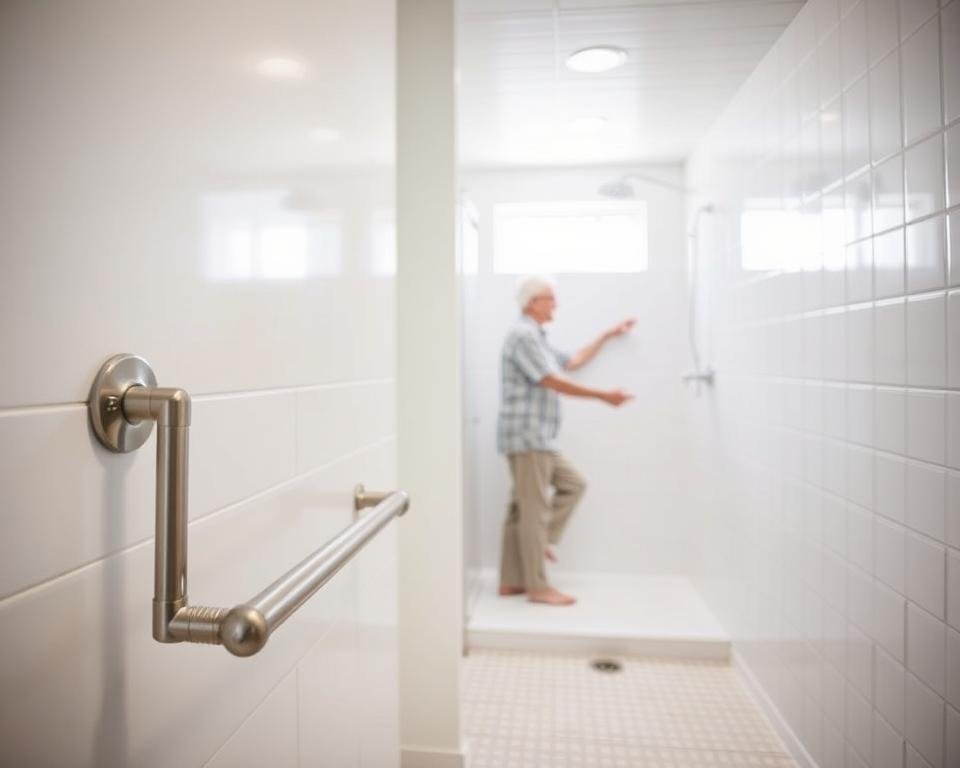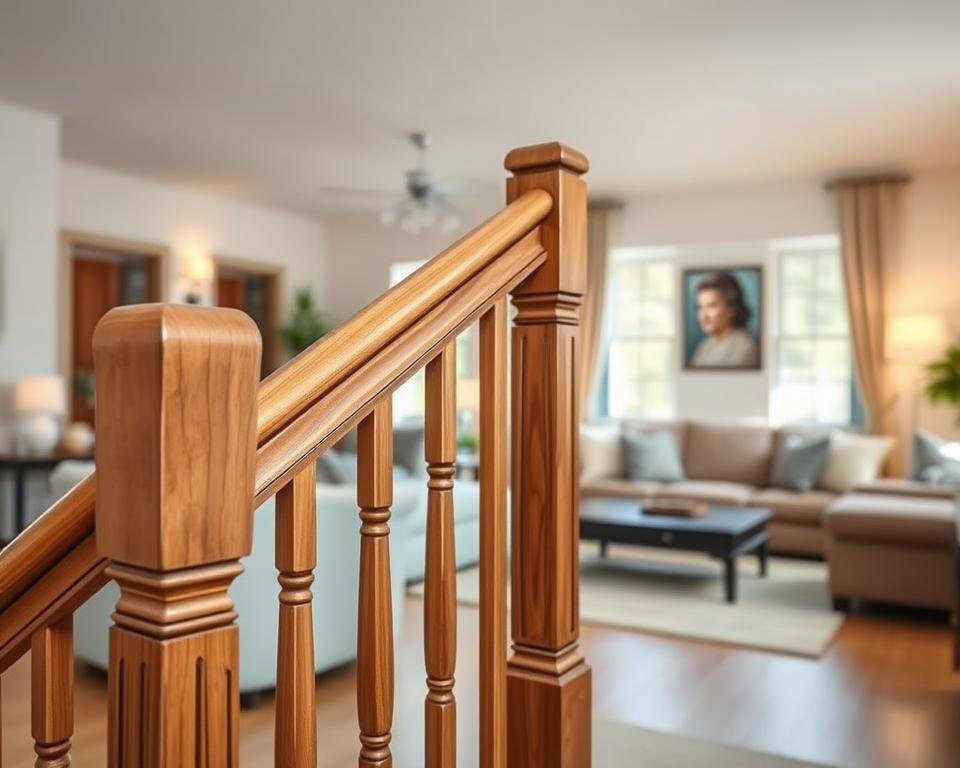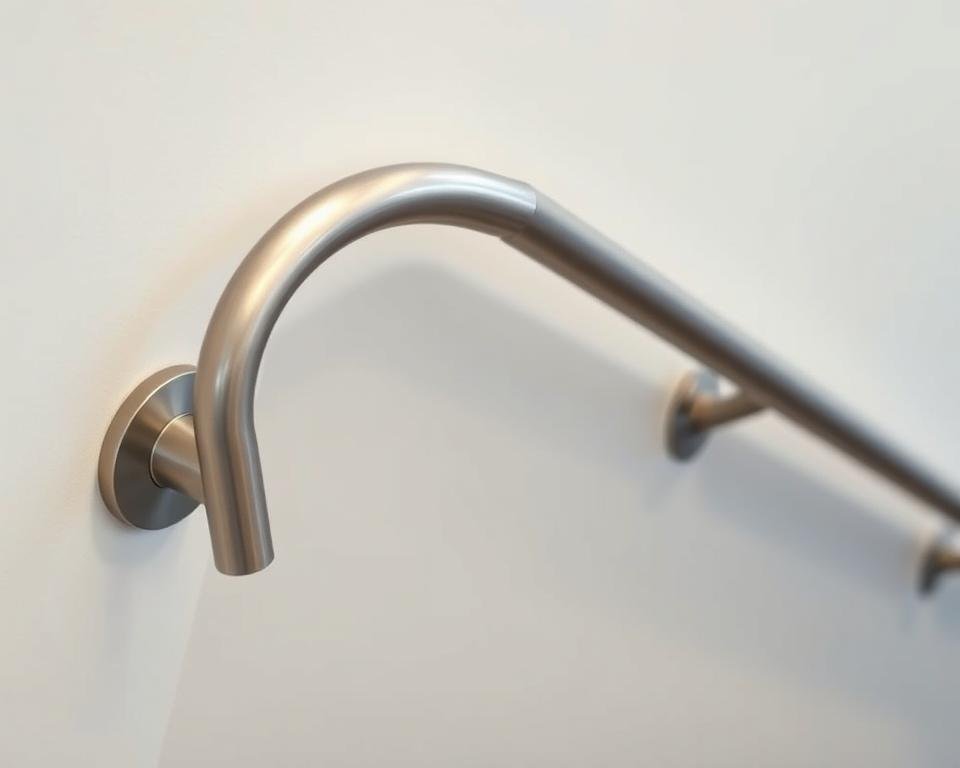“Security is mostly a superstition. It does not exist in nature… Avoiding danger is no safer in the long run than outright exposure.” – Helen Keller’s words remind us that creating a safe environment isn’t about fear—it’s about empowerment. For many, aging-in-place means maintaining independence while adapting homes to meet evolving needs.
Your home should be a sanctuary that grows with you. Simple modifications, like adding supportive features, can dramatically reduce risks while preserving comfort. Occupational therapists often note subtle signs—like worn walls or furniture shifted for balance—as cues to prioritize safety upgrades.
Functional design doesn’t mean sacrificing style. Modern solutions blend seamlessly with decor, offering stability without feeling clinical. Whether it’s a staircase or bathroom, thoughtful adjustments enhance daily life and confidence.
This guide walks you through material choices, design tips, and critical placement areas. You’ll learn how to combine practicality with aesthetics, backed by expert insights and safety standards. Let’s build a space that supports every step.
Key Takeaways
- Aging-in-place allows seniors to maintain independence while reducing fall risks.
- Safety upgrades like supportive features improve stability without compromising style.
- Subtle signs, such as furniture rearrangement, signal the need for home modifications.
- Modern designs integrate seamlessly with existing decor for a cohesive look.
- This guide covers materials, legal guidelines, and high-risk areas for informed decisions.
Understanding the Importance of Handrails for Seniors
Imagine navigating your home with the quiet confidence that every step is secure. Supportive features like handrails transform living spaces by creating reliable anchors where you need them most. Research shows these additions reduce fall risks by 52% in homes, offering both physical stability and peace of mind.

More Than Just a Safety Feature
Handrails provide three key advantages: enhanced grip, better weight distribution, and reduced strain on joints. Occupational therapists recommend the “three-point contact” method—keeping one hand on a rail while moving—to improve balance during daily activities. This simple practice can make staircases safer and showers less slippery.
Spotting the Need for Support
Your home often sends subtle signals. Scuff marks along walls? Chairs clustered near hallways? These clues suggest it’s time to add stability features. A study by the CDC found that 1 in 4 adults over 65 falls annually, but proper supports can cut this risk significantly.
Modern designs let you address safety needs without compromising style. For those exploring comprehensive mobility solutions, handrails serve as foundational upgrades that complement other adjustments. They’re not just tools—they’re partners in maintaining independence.
Handrail Installation for Older Adults: Your Buyer’s Guide
Choosing supportive features for your space combines practicality with personal preference. The right solution should feel like a natural extension of your home while addressing mobility needs. Let’s explore how to select options that blend safety with your unique aesthetic.

Practical Advice on Choosing the Right Handrail
Start by measuring high-traffic areas like staircases and hallways. Look for materials that match your lifestyle—stainless steel resists moisture in bathrooms, while wooden designs add warmth to living spaces. The CDC recommends a diameter of 1.25–2 inches for optimal grip comfort.
Check texture and shape. A slightly rough surface improves traction, and oval profiles fit more comfortably in hands than flat designs. Brands like Promenaid offer customizable options that meet ADA standards without looking institutional.
Maximizing Safety and Mobility at Home
Placement matters most. Install supports at 34–38 inches above floor level, as building codes suggest. Use stud finders to anchor securely into wall framing—this prevents wobbling during use.
Consider dual-purpose designs. A stylish rail doubling as a shelf ledge adds functionality. Contrasting colors against walls improve visibility, helping those with limited vision navigate confidently.
Test stability before finalizing. Apply firm downward pressure to ensure brackets hold weight. Properly installed features become invisible helpers, quietly boosting independence every day.
Choosing the Ideal Materials and Design Options
Your home’s character shines through every detail—including the features that keep you steady. Material choices impact both safety and visual harmony, blending strength with your unique taste. Let’s explore options that turn practical needs into design opportunities.
Comparing Wood, Metal, and Vinyl Finishes
Wood brings warmth to spaces with its natural grain patterns. Stained oak or maple suits traditional interiors, while bamboo offers eco-friendly appeal. However, wooden options require regular sealing in humid areas like bathrooms.
Metal stands out for strength reliability. Stainless steel resists rust, making it ideal for outdoor use. Powder-coated aluminum comes in bold colors for modern kitchens. Just avoid slick surfaces—textured finishes improve grip.
Vinyl shines in low-maintenance homes. It won’t warp in rain or snow, perfect for porches. Many designs mimic wood’s look without the upkeep. Pair it with reinforced brackets for extra stability.
Adapting Handrails to Your Home Decor
Match shapes to your existing lines. Curved rails soften angular rooms, while straight profiles complement minimalist layouts. Try bronze finishes against navy walls or walnut tones in sunlit hallways.
Contrast can be clever. A glossy black rail becomes a striking accent in white corridors. For subtlety, choose tones that mirror door handles or light fixtures. This creates cohesion without shouting for attention.
Ensuring Durability and Easy Installation
Check joint construction—welded metal seams last longer than screwed connections. Wood should have mortise-and-tenon joints for weight support. Many vinyl systems use snap-together parts, cutting setup time by half.
Pre-drilled mounting holes simplify DIY projects. Look for kits with adjustable brackets to handle uneven walls. Test weight capacity by hanging from the rail before final tightening. A proper fit feels solid yet blends into daily life.
Navigating Safety Standards and Building Codes
Building codes form the backbone of effective home safety measures. These rules aren’t red tape—they’re tested methods to prevent accidents and ensure stability. Over 3 million seniors visit emergency rooms annually due to falls, but proper adherence to guidelines can turn risky areas into secure spaces.

Understanding ADA Requirements and Legal Guidelines
The Americans with Disabilities Act sets clear benchmarks for supportive features. Rails must run continuously along stairs and ramps, positioned 34–38 inches high. Diameter matters too—opt for 1.25–2 inch grips that fit comfortably in palms.
Secure anchoring is non-negotiable. Brackets should attach to wall studs, not just drywall. Brands like Moen test their designs to hold 250+ pounds, meeting commercial-grade standards. While ADA compliance isn’t mandatory for private homes, following these specs maximizes safety.
Ensuring a Secure, Non-Slip Grip
Texture transforms ordinary rails into reliable supports. Look for rubberized coatings or grooved patterns that maintain traction even with wet hands. A Johns Hopkins study found textured surfaces reduce slip risks by 60% compared to smooth metals.
Test your setup before relying on it. Pour water on samples and simulate weight shifts. Products like HealthCraft’s SureGrip line undergo rigorous moisture trials to ensure year-round reliability. Pair these features with proper placement to create a home that supports confident movement.
Balancing Aesthetics with Functionality
A well-designed home marries beauty with purpose—you shouldn’t have to choose between style and safety. Modern supports blend seamlessly into your space while providing the stability needed to move confidently. Let’s explore how to achieve this harmony without sacrificing either element.
Integrating Style with Practicality in Your Home
Your home’s personality shines through thoughtful details. Opt for rails that mirror existing finishes—bronze accents in a farmhouse kitchen or sleek chrome in contemporary hallways. Brands like Moen offer textured grips that look like decorative metalwork but provide slip-resistant surfaces.
Ergonomic shapes matter too. Curved edges feel natural in your palm, while oval profiles complement modern furniture lines. Pair these with smooth joints that eliminate sharp corners, creating a cohesive look that’s gentle on hands and eyes.
Highlighting Visual Contrast for Better Visibility
Subtle isn’t always safer. A navy rail against white walls isn’t just striking—it helps those with fading vision navigate confidently. Studies show high-contrast combinations reduce missteps by 40% in low-light conditions.
Consider adding LED strips under rails for nighttime guidance. HealthCraft’s oak designs with built-in lighting prove safety features can be elegant. These touches add warmth while addressing mobility challenges quietly.
Remember: Your home should tell your story. Choose supports that feel intentional, not clinical. When every detail works this hard, you create spaces that protect and inspire in equal measure.
Implementing Handrails in High-Risk Areas
Your daily path holds hidden challenges—but smart upgrades turn risks into reassurance. While 85% of slips happen on flat surfaces like hallways, bathrooms claim 15% of fall-related injuries according to safety research. Strategic placement transforms these zones from danger spots into secure pathways.
Stairway and Pathway Protection
Stairs demand continuous guidance. Install rails on both sides, extending 12 inches beyond the top and bottom steps. This “overhang rule” helps maintain grip during transitions. Anchor brackets into wall studs every 32 inches for wobble-free performance.
Walkways thrive with consistent support. Position grips at 34-38 inches high along frequently used corridors. A Johns Hopkins study found this height range improves balance during sudden stops. Pair rails with non-slip flooring for layered safety.
Bathroom Stability Solutions
Wet surfaces become safer with vertical and horizontal bars near showers and toilets. Place one 9-13 inches above tub edges and another 33-36 inches high for seated transfers. Contrasting colors against tiles help those with vision changes locate supports quickly.
Studies show proper bathroom setups reduce fall risks by 40%. Consider angled bars near toilets for natural pushing motions during sit-to-stand movements. These subtle adjustments protect joints while blending with your decor.
By focusing on high-traffic zones, you create a network of reliable anchors. Each well-placed support becomes a silent guardian—turning everyday movements into confident strides.
Conclusion
Creating a safe living space that evolves with your needs brings peace of mind and preserves independence. Thoughtful upgrades like supportive features reduce fall risks while complementing your home’s character. Studies show homes with proper safety measures help seniors maintain mobility and confidence in daily routines.
Choosing durable materials—whether sleek metals or warm woods—ensures long-term reliability without compromising aesthetics. Pair these with ADA-recommended heights and secure anchoring to meet safety benchmarks. Strategic placement in bathrooms, stairways, and hallways creates invisible safety nets where they matter most.
Remember: Safety and style thrive together. Contrasting colors improve visibility, while textured finishes add grip subtly. By following building codes and prioritizing quality, you build a foundation that protects loved ones for years.
Use this guide to make choices that honor both practicality and personal taste. Your home deserves solutions that feel intentional—tools designed not just to prevent falls, but to enrich everyday life. Start small, think ahead, and watch your space transform into a haven of security and beauty.
